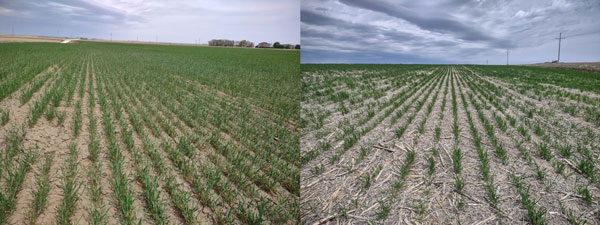The potential for high nitrate concentrations in crops such as corn, sorghum, canola, cereal grains (including wheat), and some grasses occurs after exposure to drought, hail, frost, cloudy weather, or soil fertility imbalance. Nitrates accumulate in the lower portion of these plants when stresses reduce crop yields to less than expected, based on the supplied nitrogen fertility level. Feeding harvested forages or grazing plants that are high in nitrates can be toxic to livestock because the metabolism products from nitrates interfere with the ability of blood to carry oxygen, causing asphyxiation.
Due to prolonged extreme drought conditions, many wheat stands across Kansas are thin and short this year (Figure 1). Some producers are making the decision to graze out their wheat due to very low yield potential. Under certain environmental conditions, cereal grains like wheat and oats, can accumulate potentially toxic nitrate levels. Keep in mind that nitrate levels can increase in drought-stressed plants after a rain event.

Figure 1. Drought-stressed wheat fields in north central Kansas. Photos by Sandra Wick, K-State Research and Extension.
It is wise for producers to test their drought-stricken forage prior to grazing. Wheat samples from some fields in north central Kansas were collected and tested for nitrate concentration (Table 1). Most of the samples collected were very low in nitrates (fields were sampled in early May prior to recent rain events). However, two samples collected in mid-May at a different location showed very high levels of nitrate (>6,000 ppm) after some recent rainfall. Toxicity is related to the total amount of nitrate in the diet (including water) and how quickly it is eaten, but, generally, if forages contain more than 6,000 ppm nitrate, they should be considered potentially toxic (Table 2). Animals under physiological stress (sick, hungry, lactating, or pregnant) are more susceptible to nitrate toxicity than healthy animals. Some data suggests nitrates can cause a loss of pregnancy in cattle at levels lower than death loss.
Table 1. Nitrate concentrations in drought-stressed wheat samples collected from fields in north central Kansas in May 2023.
|
Location |
Date of collection |
Nitrate (ppm) |
|
Mitchell Co. 1 |
May 3 |
24 |
|
Mitchell Co. 2 |
May 3 |
24 |
|
Smith Co. 1 |
May 3 |
31 |
|
Smith Co. 2 |
May 8 |
249 |
|
Smith Co. 3 |
May 8 |
229 |
|
Smith Co. 4 |
May 8 |
468 |
|
Smith Co. 5 |
May 8 |
164 |
|
Smith Co. 6 |
May 16 |
7398 |
|
Smith Co. 7 |
May 16 |
6703 |
Table 2. Level of forage nitrate (dry matter basis) and the potential effect on animals.
|
ppm Nitrate (NO3) |
Effect on Animals |
|
0-3,000 |
Virtually safe |
|
3,000-6,000 |
Moderately safe in most situations; limit use for stressed animals to 50% of the total ration. |
|
6,000-9,000 |
Potentially toxic to cattle depending on the situation; should not be the only source of feed. |
|
9,000 and above |
Dangerous to cattle and often will cause death. |
Nitrate testing can be done through several labs, including the K-State Soil Testing Laboratory. Producers should collect a good representative forage sample of what the cattle will graze or above the cutting height if mechanically harvesting to accurately determine the nitrate concentration.
Many of these stressed wheat fields are very low on biomass. Producers need to be careful not to remove too much material otherwise the field could be susceptible to wind erosion. Also, short-duration grazing due to low plant biomass could cause issues maintaining a consistent diet and minimizing bloat for newly weaned calves or maintaining a consistent diet for conditioning cattle for breeding. The wheat intended for grazing is high in crude protein and energy and is an excellent feed resource during this drought period.
For more information on nitrate toxicity in forages, please see KSRE publication MF3029 Nitrate Toxicity at https://www.asi.k-state.edu/doc/forage/fora13.pdf
Dorivar Ruiz Diaz, Soil Fertility Specialist
ruizdiaz@ksu.edu
Sandra Wick, Crop Production Agent – Post Rock District
swick@ksu.edu
John Holman, Cropping Systems Agronomist, Southwest Research-Extension Center
jholman@ksu.edu